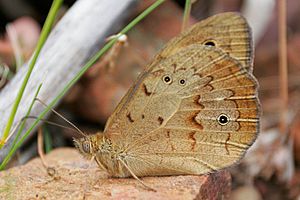Common xenica facts for kids
Quick facts for kids Common xenica |
|
|---|---|
 |
|
| Scientific classification | |
| Kingdom: | |
| Phylum: | |
| Class: | |
| Order: | |
| Family: | |
| Genus: |
Geitoneura
|
| Species: |
G. klugii
|
| Binomial name | |
| Geitoneura klugii (Guérin-Méneville, 1830)
|
|
The common xenica (scientific name: Geitoneura klugii) is a type of butterfly. It belongs to the Nymphalidae family, also known as brush-footed butterflies. This butterfly lives in southern Australia. It's good at camouflage because its colors help it blend in with the ground. You'll often see it fluttering close to the earth.
This butterfly has a wingspan of about 38 millimeters (1.5 inches). Its front wings are mostly black with brownish-black patterns. They also have a black spot with a white center. The back wings are orange with a black border. They also have a black-rimmed eyespot, which looks like a small eye. The underside of the back wings can be grey or brown with darker patterns.
Contents
Life Cycle of the Common Xenica
The common xenica butterfly goes through several stages in its life. These stages are egg, larva (caterpillar), pupa, and finally, the adult butterfly.
How Common Xenica Eggs Develop
When first laid, the eggs are white or pale yellow. After a few days, they slowly turn a speckled purple color. Each egg has a flat top and bottom. Its shell is moderately thick with 14 to 18 rib-like lines.
These eggs stay dormant (inactive) during the hot Australian summer. The tiny larva inside only starts to grow when autumn rains begin. It also needs cooler temperatures or shorter daylight hours. The larva will not hatch until the eggs get wet from long autumn showers.
When a larva is ready to hatch, it partly cuts open the eggshell. Then it pushes its way out. Often, the larva eats its own eggshell right away. This helps give its weak body some quick nourishment. After that, it looks for young grass to eat more.
What Common Xenica Larvae Look Like
In its first stage, the larva (caterpillar) is pale grey. It has brown lines running along its body. It also has many hair-like structures with black knobs. Its head is brown and has no horns. The rear part of its body does not have a fork.
As the larva grows through later stages, its rear develops a fork. The brown lines on its body turn green. The larva itself also becomes green. A fully grown larva is green and about 28 millimeters (1.1 inches) long.
These larvae eat from winter through early spring. They feed on different types of grasses. Some of their favorite foods include slender tussock grass, kangaroo grass, and false brome.
The Pupa Stage of the Common Xenica
When it's time to become a pupa, the larva turns yellowish-green. The lines on its body disappear. The pupa stage lasts for 16 to 29 days. This happens during late spring and early summer. The time spent as a pupa gets shorter during the hottest part of summer.
The pupae are 11–13 millimeters (0.4–0.5 inches) long and pale green. They hang upside down from a silky pad on their abdomen. This pad is called a cremaster. They can hang from a log, a food plant, or a stick.
Where Common Xenica Butterflies Live
Geitoneura klugii butterflies are found in temperate parts of southern Australia. These areas usually get more than 100 millimeters (4 inches) of rainfall. They prefer cool, damp places where there is plenty of green food.
You can find them in southern Queensland, eastern New South Wales, and most parts of Tasmania and Victoria. They also live in southern Western Australia and along the coast of South Australia.
Why is it Called Klug's Xenica?
The scientific name Geitoneura klugii and the common name "Klug's xenica" honor a person. They are named after Johann Christoph Friedrich Klug. He was a famous German entomologist, a scientist who studies insects.
See also
 In Spanish: Geitoneura klugii para niños
In Spanish: Geitoneura klugii para niños

